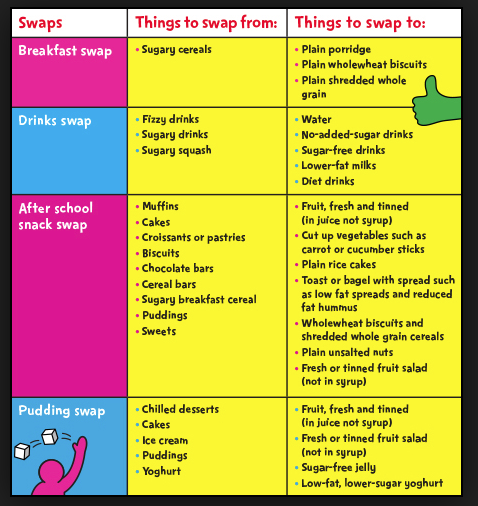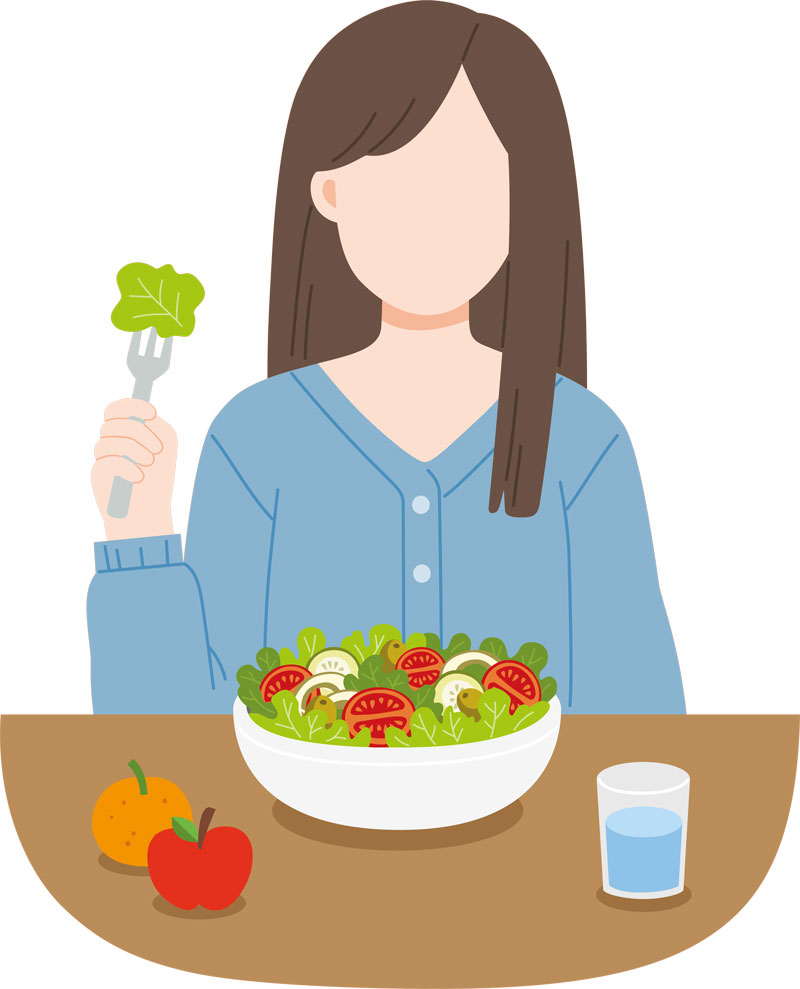Healthy eating
Our modern lifestyle is often geared toward eating too much and moving too little. This can result in our children growing up to have dangerous levels of fat in their bodies and cause life-threatening diseases like cancer, heart disease and type2 diabetes. In addition, being overweight can limits the way we live and enjoy our lives.
So it is important that we all: Eat well, move more, live longer.
Change4Life advocates making changes to the way we eat and the amount we move around so we can reap the long-lasting benefits.
Watch the sugar!
There are lots of different words used to describe sugar (i.e. sucrose, glucose, fructose, maltose, hydrolysed starch, invert sugar, corn syrup, honey) and it is important to read food labels with care as even foods that do not taste sweet can contain a lot of sugar.
Too much sugar means extra calories, which cause fat to build up and could lead to heart disease, some cancers and type 2diabetes. Eating too much sugar can also cause tooth decay.
The highest contributors to added sugar in the diet of 4 to 10 year olds are sugary drinks, cereal and cereal products, preserves, biscuits and cakes and from milk and milk products.
Change4Life – Sugar Infomercial
Cut back the fat!
Too much fat is bad for us! It is difficult to cut down as fat seems to be in so many things we like. There are two kinds of fat in the foods we eat – saturated and unsaturated fat. We need a bit of fat in our diets to help our bodies absorb vitamins and stay healthy, but we should not have too much saturated fat (found in butter, cheese, cakes, biscuits, pastries and fatty meats like streaky bacon and sausages) as this type of fat can build up in the body, leading to serious problems like a heart attack or stroke. Eating too much fat also causes us to gain weight.
As a general guide:
high fat foods have more than 17.5g fat per 100g and low fat foods have 3g or less per 100g
Change4Life – Fats Infomercial
Salt
To stay healthy, adults eat no more than 6g of salt a day for adults (approximately a teaspoonful) A guide for children in regard to salt intake is:
Kids aged one to three – 2g salt a day (0.8g sodium)
Kids aged four to six – 3g salt a day (1.2g sodium)
Kids aged seven to 10 – 5g salt a day (2g sodium)
Kids aged 11 and over – 6g salt a day (2.4g sodium)
Change4Life – Salt Infomercial
Start your day with a healthy breakfast!
Having a good breakfast is an important part of being healthy. Eating breakfast gives us the energy we need until lunchtime and can help to cut-down on snacking throughout the morning. However, it is important that we choose the right kind of breakfast and avoid foods that are high in sugar or fat.
Good breakfast foods include:
- Fruit and vegetables: all fruit and vegetables that are fresh, tinned, dried, frozen or in juice form are good for you. (try to avoid tinned fruit in syrup as these are higher in sugar than those in their own juice.)
- Starchy foods: bread (especially wholemeal), rice and cereals (especially wholegrain) that are low in-sugar and salt.
- Milk and dairy: cheese, low-fat yoghurt and lower-fat milk.
- Non-dairy protein: meat, fish, eggs, beans and unsalted nuts.
Go easy on breakfast spreads that are high in fat, sugar and salt (e.g. jam, butter and yeast extract)
Snacking
We all tend to snack more than we realise. It is easy to grab a chocolate bar or a bag of crisps if we are hungry, instead of reaching for something healthier. Snacks can be full of hidden ‘nasties’- like saturated fat, salt and sugar. And in time, too much of these can lead to serious health problems like heart attack, stroke and type 2 diabetes.
Most kids like to snack – the down side is that most of the tastiest snacks are full of fat, sugar and salt.
Do not try and cut out the kids’ favourite snacks all at once – just ease them in gently. Aim for three regular healthy meals a day to reduce the need for snacking. A few simple tips that will probably not be noticed are:
- Two snacks Max – one in the morning and one in the afternoon.
- Keep count – keep an eye on the number of snacks you eat- you will be more likely to cut down
- Chop up the choc – cut up regular-sized chocolate bars and give them a little piece instead of a whole bar.
- Thirsty instead? – If your kids ask for more snacks after you think they have had enough, they may be thirsty instead of hungry. Try offering them water or low fat milk (skimmed, semi-skimmed or 1%, as long as they are aged over five) instead.
Healthier alternatives to sweet snacks
- Chunks of melon, strawberries, grapes, or any fruit that is in season.
- Dried Fruit–just a few pieces of mango, banana, pineapple, cranberries or raisins(small handful) is about the right amount of dried fruit for kids.
- Low fat fruit yoghurt.
- A handful of dry reduced sugar cereal with a few raisins or sultanas.
Healthier savoury snack ideas
- Baked crisps
- Small handful of unsalted mixed nuts
- Pumpkin and sunflower seeds
- Pitta and lower fat dips like salsa or reduced fat hummus
- Rice cakes with lower fat cream cheese and cucumber
- Celery sticks filled with lower fat cream cheese
- Homemade popcorn (without sugar or salt)
- Unsalted rice cakes, corn cakes or oatcakes
- Veg sticks – carrot, celery, baby sweetcorn, peppers and radishes with a reduced fat hummus dip
- Sliced apple and a lower fat soft cheese to dip
Easy Food Swaps
Breakfast fat swaps
- Milk: use 1% fat milk on your cereal. It has about half the saturated fat of semi-skimmed.
- Sausages: compare nutrition labels on the packs and choose the ones lower in saturated fat. Try grilling sausages instead of frying.
- Bacon: choose back bacon instead of streaky bacon and grill instead of frying.
- Eggs: prepare eggs without oil or butter (Poach, boil or dry-fry your eggs).
- Swap pastries for thin pancakes with fruit, or crumpets with a thin layer of jam.
- Toast: have sliced banana on whole grain toast instead of white toast and butter.
Lunch and Dinner fat swaps
- Potatoes: make your Sunday lunch roast potatoes healthier by cutting them into larger pieces and using just a little sunflower or olive oil.
- Chips: choose thick, straight-cut chips instead of French fries or crinkle-cut. At home, choose oven chips and if you are making your own chips from scratch, cook them in the oven with a drizzle of sunflower oil, rather than deep-frying.
- Mashed potato: use reduced-fat spread instead of butter, and 1% fat milk or skimmed milk instead of whole or semi-skimmed milk.
- Cheese can be high in saturated fat – check the label and choose cheese that is lower in saturated fat. Grated cheese will go further than sliced cheese as will a strong-tasting cheese, such as mature cheddar,
- Spaghetti Bolognese: use a leaner mince. It’s lower in saturated fat. If you aren’t using leaner mince, brown the mince first, then drain off the fat before adding other ingredients.
- Fish pie: use reduced-fat spread and 1% fat milk to make the sauce.
- Chilli: use leaner mince to reduce the saturated fat content; or try a vegetarian-style for a change by adding beans, pulses and vegetables instead of mince.
- Meat: trim the visible fat off all meat.
- Pasta: try a tomato sauce on your pasta instead of a creamy, cheesy or meat sauce.
- Pizza: choose a lower-fat topping, such as ham, vegetables, fish or prawns, instead of pepperoni, salami or extra cheese.

5 A DAY Tips
Fruits and vegetables are a source of vitamins, minerals and fibre which may help reduce the risk of diseases like heart disease and some cancers. It can be easier than you think to get your 5 A DAY.
5 A DAY at Breakfast
- Add fruit to cereal, porridge or lower fat yoghurt (a handful of berries, a chopped banana is lovely or a little dried fruit, but not too much as it can be high in sugar).
- Try having one glass (150ml) of 100% unsweetened fruit or vegetable juice or smoothie per day. This also counts as one portion or a maximum of two portions if the smoothie contains all the edible fruit or vegetable in the amount that you drink.
5 A DAY at Lunch
- Add some crunch to sandwiches with cucumber, grated carrot or tomato, and have a piece of fruit.
- A piece of fruit or veg can help cheer up a lunchbox. Try carrot sticks, baby tomatoes or a banana
5 A DAY at Dinner
- Add chopped carrots to spaghetti Bolognese.
- Add red peppers to a pasta sauce.
- Mix peas into mashed potato.
- Sprinkle pepper, onion, mushroom, sweet corn or pineapple chunks on top of a thin-based pizza.
- Have a salad or vegetables with your main meal.
- If I is a roast dinner, make sure you have some vegetables on your plate. Try carrots, broccoli, beans, peas, cauliflower, courgettes…
- Add lentils, beans and peas to stews, bakes and salads.
5 A DAY Snacks
- Sticks of cucumber, pepper, carrot and cauliflower florets all go great with lower fat dip, lower fat cheese spread or salsa
- Keep some chunks of fresh fruit in the fridge, ready to snack on.. Try just a few raisins or dried apricots – not too many though, as they contain a lot of sugar.
Get your portion size right!
We don’t all need to eat the same calories, remember children need smaller portions than adults.
When children regularly eat more than they need, the food converts to stored fat in their bodies. It is important to be conscious of their portion size, if they begin with a smaller portion they are more likely to eat it; and they can always come back for seconds if they are still hungry.
Give a portion which matches their age. Making a fist is a good guide to gauge portion sizes; remember a child’s fist will be a lot smaller than an adults, and so will their stomach.
For example…
- One portion of fruit (80g) is roughly equivalent to a slice or half a large fruit (slice of melon or half a grapefruit);1 medium size fruit (an apple); 2 small size fruits ( 2 plums or satsumas).
- A portion of dried fruit (30g) is roughly equivalent to a heaped tablespoon of dried fruit
- A portion of vegetables (80g) is roughly equivalent to 3 heaped tablespoons of peas, beans or pulses; 2 broccoli spears; a dessert bowl of salad.


